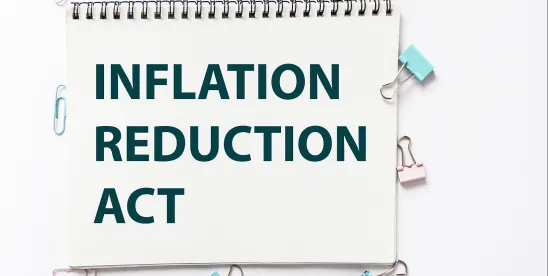With November elections drawing near, the Biden Administration is racing to cement its domestic policy achievements, notably key provisions of the Inflation Reduction Act (IRA) – a multi-billion-dollar federal clean energy, climate and domestic manufacturing legislation signed into law on August 16, 2022.
With significant IRA provisions still awaiting formal guidance and implementation, several IRA programs and incentives are at risk of significant delays or full repeal if Republicans retake control of Congress and/or the White House.
In late 2022, the Biden Administration began releasing agency guidance, funding announcements, Notices of Proposed Rulemaking and notices of funding opportunity (NOFOs) to further define program parameters for entities seeking access to the IRA’s historic tax incentives and federal funding opportunities. State and local governments, and various industries are eager for the White House to publish final guidance and implement numerous IRA programs, many of which have been delayed for over a year. Even so, eligible entities have capitalized on current IRA programs that direct funding and tax incentives to manufacturing projects, rural energy projects and major climate planning programs. Looking ahead, stakeholders can expect IRA implementation to accelerate over the summer as the Biden Administration looks to put the historic funding into action and guard against future challenges to the IRA’s provisions.
IRA implementation has not been without criticism, foreshadowing potential challenges for IRA programs and initiatives. Industry and independent groups have expressed concern over delays in implementing key IRA provisions, including tax incentives for clean fuels, clean hydrogen and low demand for clean energy technologies receiving IRA incentives, such as electric vehicles (EV). Congressional Republicans and key IRA sponsor Senator Joe Manchin (DWV) have also criticized the Biden Administration’s guidance on critical minerals and foreign entities of concern amid broader congressional concerns over supply chain resilience and economic reliance on China, and as recently as June 13, former President Donald Trump vowed to completely reverse the Biden Administration’s EV mandates before a group of Republican Members of Congress.
What is the Status of IRA Implementation?
From late 2022 through 2023, Phases 1 and 2 of IRA implementation included Treasury Department and Internal Revenue Service (IRS) guidance on more than 50 IRA provisions, including proposed guidance on the Section 30D Clean Vehicle Credit, Section 45X Advanced Manufacturing Production Tax Credit, direct pay provisions and bonus credit rates for workforce development programs and investment in low-income communities.
In early 2024, the Treasury Department announced the beginning of Phase 3 of IRA implementation. Phase 3 has already addressed issues from earlier implementation phases and included final guidance on the Section 30D Clean Vehicles Credit and new technology-neutral Clean Electricity Production and Investment Credits.
In addition to IRA guidance and tax credits, federal agencies administering IRA grant programs have released NOFOs and funding announcements for major IRA funding programs, including the Environmental Protection Agency’s Greenhouse Gas Reduction Fund (GGRF), Climate Pollution Reduction Grants and Clean Heavy-Duty Vehicles Programs and the Department of Energy’s Domestic Manufacturing Conversion Grant and Home Energy Rebate Programs. In addition, IRA funding has been awarded from several new and existing programs administered by the US Department of Agriculture (USDA) and US Department of Transportation (USDOT).
Guidance and details on several major IRA programs and incentives remain outstanding. Most notably, final rules for the Clean Hydrogen Credit (Section 45V) have yet to be announced by the Treasury Department amid disagreements between industry, the US Department of Energy and environmental advocates over the design of the credit. The delay of the proposed Section 45V rules, originally expected in 2023, prompted industry concern over the ability to take full advantage of the credit before its sunset in 2033. In addition, final guidance for the Section 45X Advanced Manufacturing Production Tax Credit remains outstanding, and billions of dollars in IRA funding for grants and loans for ports, electric vehicles, climate programs and energy incentives remains unspent.
“Both parties have turned to the budget reconciliation process over the past decade or so to enact major policy changes without buy-in from the opposition party. One of the side effects of using that approach is that there’s usually some uncertainty that comes after the law takes effect about whether the law is here to stay. You’re seeing that play out now with respect to the IRA, with many people with a stake in the implementation of the law looking ahead to 2025 and trying to figure out what the future might hold if there’s a shift in the balance of power.”
Former US House Speaker John Boehner (R-OH),
Senior Strategic Advisor, Squire Patton Boggs.
What Happens if IRA Implementation Stretches into 2025?
Risk 1 – Congressional Challenges to Biden Administration Rules
If Republicans hold the House, regain control of the Senate and hold the keys to 1600 Pennsylvania Avenue, congressional Republicans may seek to use the Congressional Review Act (CRA) to overturn IRA rules issued at the end of the Biden Administration. Broadly, the CRA allows Congress to overturn certain rules issued by federal agencies through a joint resolution of disapproval within sixty legislative days after a rule is submitted to Congress. The successful use of the CRA prevents a rule from taking effect or continuing in place and prevents the reissuance of substantially similar rules unless authorized by a subsequent Act of Congress. Joint resolutions of disapproval may be adopted by simple majority and cannot be filibustered in the Senate. Importantly, joint resolutions of disapproval are subject to a Presidential Veto. Should President Biden secure a second term, CRA possibilities are likely null and void.
Leveraging the CRA to repeal prior rulemakings effectively requires one-party control of the White House and Congress. Notably, Republicans successfully overturned 16 Obama Administration rules, and Democrats successfully overturned 3 Trump Administration rules, following a change in party control of the White House and Congress.
Further, which Biden Administration rules are subject to the CRA depends on the number of days Congress is in session in 2024. Because CRA joint resolutions of disapproval must be filed within 60 consecutive days (which run concurrently so long as Congress does not adjourn or “gavel out” for more than three days) following the submission of a rule to Congress, fewer legislative days at the end of the 118th Congress may expose more Biden Administration rules issued in 2024 to CRA scrutiny. In 2020, rules issued after August 21 were subject to subject to the CRA at the start of the 117th Congress.
In effect, the successful use of the CRA could rescind critical rules promulgated under the IRA, as well as rules on climate, emissions, prescription drugs and other topics that impact ongoing IRA programs and initiatives. In addition, the CRA could hinder subsequent presidential administrations from reissuing similar rules, absent congressional action.
Notably, Members of Congress are already introducing CRA challenges to major IRA provisions. In May, Sens. Joe Manchin (D-WV) and Sherrod Brown (D-OH) introduced a Joint Resolution (S. J. Res. 87) to overturn the Biden Administration’s final rules implementing the Inflation Reduction Act’s Section 30D Clean Vehicle Credit, and Reps. Carol Miller (R-WV) and Jared Golden (D-ME) introduced a companion resolution in the House (H. J. Res. 148). The bipartisan Members of Congress have argued that the Biden Administration’s final rules implementing the Clean Vehicles Credit are too lenient on automaker supply chains that rely on minerals and battery components from China. The remaining legislative calendar will ultimately determine whether the House and Senate resolutions can be reintroduced in the 119th Congress.
Risk 2 – Legislative Changes
If Republicans control Congress and the White House in 2025, Republican leaders may also seek the partial or full repeal of the IRA. In the 118th Congress, Republicans have showed their hand as to what programs may be on the chopping block. In March 2023, the US House of Representatives passed the Lower Energy Costs Act (H.R. 1), which would repeal several IRA programs, including the Methane Emissions Reduction Program, and the $27 billion Greenhouse Gas Reduction Fund. Subsequently in April 2023, the House passed the Limit, Save, Grow Act of 2023 (H.R. 2811) debt ceiling legislation that also included provisions to repeal several IRA energy tax credits and rescind IRA funding from climate programs.
Full or partial repeal of IRA provisions may result in opposition from industry and recipients, including state and local governments, of IRA tax incentives. In addition, as IRA tax credits continue to be allocated and awarded by the Biden Administration, full or partial repeal of the IRA may become less likely. Notably, former Trump Administration Secretary of Energy Dan Brouillette also recently predicted that the “vast majority” of the IRA will withstand attempts at repeal, including the IRA’s technology-neutral clean energy tax credits.
Nevertheless, congressional Republicans may seek to limit the overall cost of IRA grant programs and tax credits, including by rescinding funding for unimplemented programs, strengthening critical minerals or battery component requirements of vehicle credits, or by reducing bonus credit rates. Industry should also monitor for the risk of potential bipartisan changes to IRA programs, such as extending the “beginning of construction” deadline for clean energy tax credit eligibility, strengthening foreign entities of concern requirements, capping IRA tax incentives and more. Lowering the overall cost of the IRA’s tax incentives, particularly for EVs and green energy investment, is likely to be an attractive option for congressional Republicans should they control Congress in 2025, particularly as Congress considers extensions of Trump-era tax cuts.
Risk 3 – Executive & Regulatory Action
Finally, if Republicans control the White House in 2025, further IRA implementation may be constrained by executive or regulatory action. First, a Republican president may utilize the agency rulemaking process to suspend or delay the finalization of IRA-related rules pending before federal agencies. Freezing the completion of pending regulations is a common practice of incoming presidential administrations. This tactic could provide a Republican president with the opportunity to reshape IRA programs or delay their effect. For instance, a Republican White House could seek to narrow prevailing wage and apprenticeship incentives in pending IRA tax credits or loosen environmental standards in pending hydrogen and clean energy tax credits to provide incentives for less environmentally friendly fuels or energy sources.
Second, a future Republican administration may amend existing IRA rules to reflect Republican priorities, including stricter rules for critical minerals sourced outside the US or less stringent energy efficiency requirements. Finally, a future Republican administration may delay or withhold the award of federal funding under IRA programs.
Delaying the award of IRA grant and loan programs may “run out the clock” on certain IRA funding, including programs with funding available through 2026. Delaying the award of funding may also provide a future Republican-led Congress the opportunity to rescind certain IRA funding or terminate the authorization of IRA loan funding. The recission of IRA funding may also be included as an offset for future Republican spending priorities, including to lessen the budgetary impact of future tax legislation.
What are the Risks to Biden’s Other Legislative Achievements?
In addition to the IRA, the Biden Administration has focused on implementing its other significant legislative achievements, including the Infrastructure Investment and Jobs Act (IIJA) and CHIPS and Science Act, which provide significant funding and incentives for domestic infrastructure improvements and semiconductor manufacturing, respectively. While Republicans in Congress or the White House could utilize similar methods to delay or frustrate implementation of IIJA or CHIPS and Science Act programs, unlike the IRA, both the IIJA and CHIPS and Science Act enjoyed modest bipartisan support in Congress. Since the bills’ enactment, Republicans in the House and Senate have also celebrated investments from the IIJA and CHIPS and Science Act within their states and districts, indicating increased support for the bills’ programs as compared to the IRA. As a result, the wholesale repeal or defunding of IIJA and CHIPS and Science Act programs is less likely.
Nevertheless, aspects of IIJA and CHIPS and Science Act programs may be at risk under a Republican-led Administration. Most notably, if Republicans control the White House in 2025, unfinished IIJA and CHIPS and Science Act regulations are likely to be frozen and significant final rules, such as the Biden Administration’s Build America, Buy America guidance, are likely to be at risk of regulatory changes. In addition, a future Republican administration may modify agency funding notices and grant requirements to remove incentives for underserved communities or other areas prioritized in the Biden Administration’s Justice40 initiative.






 />i
/>i

